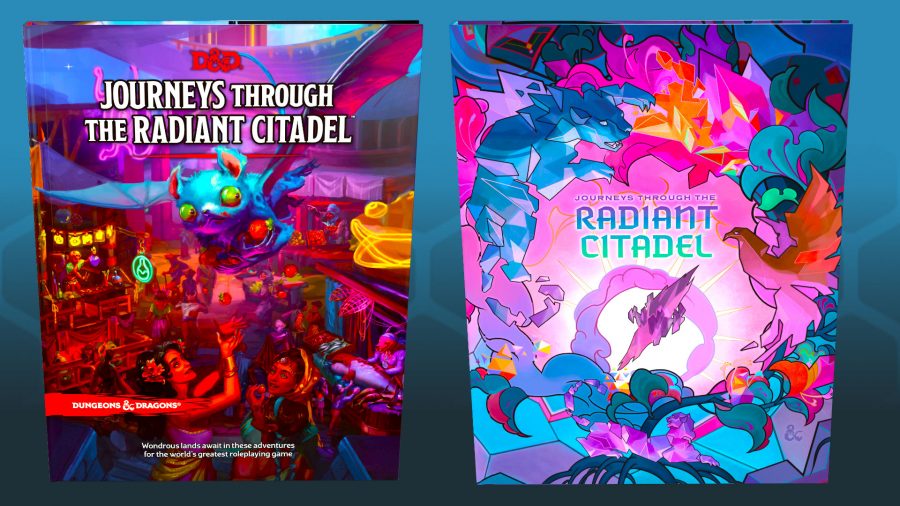Our Verdict
The adventures in Journeys Through the Radiant Citadel are fun, colourful, and thought-provoking, and the anthology structure D&D used before is as effective as ever before. The weakest links, though few, perhaps come when the book is used as a complete campaign.
It’s tough to find a DnD book that welcomes everyone to the table. Tabletop RPGs promise so many different ways to run and play campaigns that no one sourcebook can cater to every experience. Veteran storytellers can feel too railroaded by pre-written campaign books, and newcomers can be left adrift by encyclopaedias of new monsters, classes, and mechanics. On top of that, a lack of diverse representation in D&D until recent years made people feel unwelcome at the table in a whole other, uglier way.
Journeys Through the Radiant Citadel smashes all of these hurdles and then throws open the gates to welcome us inside. The newest D&D book is something of a spiritual sequel to Candlekeep Mysteries, the adventure anthology that tackled many of the same barriers to diversity and gameplay approachability.
Both books tie their adventures together with a single concept. Where Mysteries has Candlekeep Fortress, the new book has the titular Radiant Citadel, a hopepunk-style safe haven of a city floating on a massive gem out in the Ethereal Plane. From here, you can travel to the homes of the different civilisations that founded the Radiant Citadel – the sites of your adventures.
We at Wargamer loved Candlekeep Mysteries (just check out our review). However, Journeys Through the Radiant Citadel takes Candlekeep’s formula and adds to it. It primarily does this using gazetteers to provide additional lore and adventure prompts in the setting of each adventure. The explanations are structured similarly to those given for the Domains of Dread in Van Richten’s Guide to Ravenloft (which isn’t a shock, given the Ravenloft book inspired Radiant Citadel in the first place).
The gazetteers mean Radiant Citadel’s adventures are able to give the best of both worlds when it comes to different styles of Dungeon Mastering. The adventures themselves are written in a highly approachable way that would suit newer DMs, while the gazetteer encourages more experienced DMs to travel off the beaten path and create their own stories. There’s even a section dedicated to other lands tied to the Radiant Citadel – lands the reader can develop themselves.

There’s perhaps not quite enough meat for fresh-faced Dungeon Masters who want to run Radiant Citadel cover-to-cover. There’s no overarching campaign story linking the adventures together, so the DM will have to do some creative prep work to make that happen. However, if you’re thinking of buying an anthology of adventures, you probably aren’t expecting (or even necessarily wanting) a structured campaign book. And for an anthology of standalone adventures, Radiant Citadel’s attempt to cater to a variety of DMs is commendable.
Radiant Citadel’s adventures are also tied together by a larger idea. Each of the fourteen adventures was crafted by a group of black or brown TTRPG writers, and each writer gives the reader a detailed private tour of a world inspired by their heritage.
This concept alone is still pretty groundbreaking in the world of tabletop RPGs, but it’s made more so by the hopeful approach the Radiant Citadel has. This is a world where the environment and the communities it houses are protected and valued; a world where adventures often reward for empathy over violence; a world that’s refreshing when every popular fantasy RPG these days feels the need to have darkness and grit for (ironically, in a fantasy setting) the sake of realism.
The use of gemstone imagery in Radiant Citadel is appropriate – each of the settings introduced is dazzling. The Radiant Citadel is your ticket to lush jungles, sprawling underwater cities, unstable volcanoes, and vibrant festivals. Every character you encounter is as memorable as they are complex, and each adventure tackles deep, real-world themes without sacrificing the fun factor.

(Note: very minor content spoilers ahead for anyone who wants to go in completely fresh).
Early adventures Salted Legacy and Written in Blood are both excellent, but they’re as different as night and day – one giving you some truly horrifying monster combat scenarios, and the other challenging you to win a spicy pepper-eating competition.
For me, the real standout adventures were the higher-level ones. Orchids of the Invisible Mountain and In the Mists of Manivarsha were among the true gems, but 11th-level adventure Shadow of the Sun really – well, shone brightest. It offers the player complex political decisions at the same time as high-speed magic carpet rides, and the pre-written adventure has huge potential to inspire a larger campaign I’d want to play.
I do have some issues with adventures in the Radiant Citadel, though. Firstly, a few of the mid-book campaigns have plot beats that are a little too similar to each other. This won’t be as much of an issue if you’re picking and choosing what to take from the anthology, but played back-to-back, a few story aspects feel slightly repetitive.

Secondly, there’s no campaign (overarching or otherwise) that takes place in the Radiant Citadel, which is a shame for anyone who isn’t interested in creating their own. Though it acts as a vehicle to many other vibrant worlds, the Radiant Citadel is a city in itself that’s intriguing enough to warrant further exploration.
Overall, the adventures included go beyond fun – they’re thoughtful and genuine. Radiant Citadel isn’t just a groundbreaking book because it’s written by black and brown writers – it’s celebrating the culture of every writer involved in a way that welcomes you to participate, whatever your personal background, level of experience, or preferred play-style. If this is what we can expect from D&D going forward, the future is looking bright.
